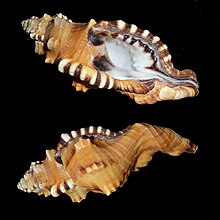Lotoria lotoria
| Lotoria lotoria Temporal range:
| |
|---|---|

| |
| A shell of Lotoria lotoria with the periostracum removed | |
| Scientific classification | |
| Domain: | Eukaryota |
| Kingdom: | Animalia |
| Phylum: | Mollusca |
| Class: | Gastropoda |
| Subclass: | Caenogastropoda |
| Order: | Littorinimorpha |
| Family: | Cymatiidae |
| Genus: | Lotoria |
| Species: | L. lotoria
|
| Binomial name | |
| Lotoria lotoria (Linnaeus, 1758)
| |
| Synonyms | |
| |
Lotoria lotoria, common name the black-spotted snail or washing bath triton, is a species of predatory sea snail, a tropical marine gastropod mollusc in the family Cymatiidae. This species was previously known as Cymatium lotorium.[2]
Fossil records

Fossils from this family date back to the Eocene (age range: from 55.8 to 0.012 million years ago).[3]
Description
Shells of Lotoria lotoria can reach a size of 90–160 millimetres (3.5–6.3 in).[4][5]
Distribution
This species of marine snail lives in the tropical Indo-Pacific oceans.[5][6]
Habitat
Lotoria lotoria is quite common in coral reefs in Australia and the Indian Ocean.
References
- ^ WMSDB
- ^ Lotoria lotoria (Linnaeus, 1758). Retrieved through: World Register of Marine Species on 6 December 2018.
- ^ Taxon 9721; Fossilworks
- ^ Cymatium lotorium; on Jaxshells online
- ^ a b "Lotoria lotoria". Gastropods.com. Retrieved 12 January 2019.
- ^ Discover life
- Linnaeus, C. (1758). Systema Naturae per regna tria naturae, secundum classes, ordines, genera, species, cum characteribus, differentiis, synonymis, locis. Editio decima, reformata. Laurentius Salvius: Holmiae. ii, 824 pp
- Drivas, J.; Jay, M. (1987). Coquillages de La Réunion et de l'Île Maurice. Collection Les Beautés de la Nature. Delachaux et Niestlé: Neuchâtel. ISBN 2-603-00654-1. 159 pp
- Liu J.Y. [Ruiyu] (ed.). (2008). Checklist of marine biota of China seas. China Science Press. 1267 pp
